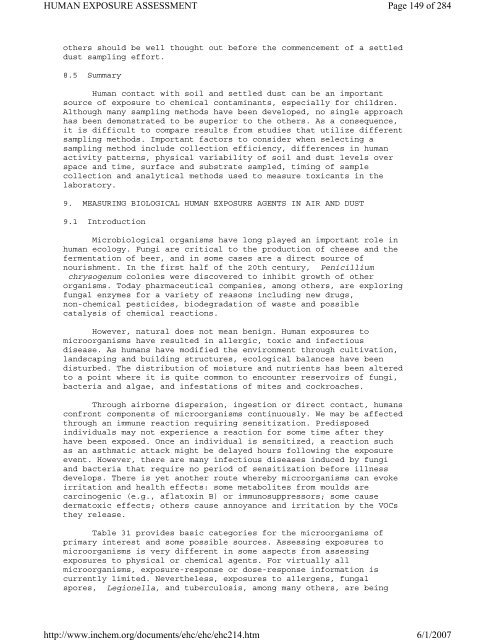Environmental Health Criteria 214
Environmental Health Criteria 214
Environmental Health Criteria 214
Create successful ePaper yourself
Turn your PDF publications into a flip-book with our unique Google optimized e-Paper software.
HUMAN EXPOSURE ASSESSMENT<br />
others should be well thought out before the commencement of a settled<br />
dust sampling effort.<br />
8.5 Summary<br />
Human contact with soil and settled dust can be an important<br />
source of exposure to chemical contaminants, especially for children.<br />
Although many sampling methods have been developed, no single approach<br />
has been demonstrated to be superior to the others. As a consequence,<br />
it is difficult to compare results from studies that utilize different<br />
sampling methods. Important factors to consider when selecting a<br />
sampling method include collection efficiency, differences in human<br />
activity patterns, physical variability of soil and dust levels over<br />
space and time, surface and substrate sampled, timing of sample<br />
collection and analytical methods used to measure toxicants in the<br />
laboratory.<br />
9. MEASURING BIOLOGICAL HUMAN EXPOSURE AGENTS IN AIR AND DUST<br />
9.1 Introduction<br />
Microbiological organisms have long played an important role in<br />
human ecology. Fungi are critical to the production of cheese and the<br />
fermentation of beer, and in some cases are a direct source of<br />
nourishment. In the first half of the 20th century, Penicillium<br />
chrysogenum colonies were discovered to inhibit growth of other<br />
organisms. Today pharmaceutical companies, among others, are exploring<br />
fungal enzymes for a variety of reasons including new drugs,<br />
non-chemical pesticides, biodegradation of waste and possible<br />
catalysis of chemical reactions.<br />
However, natural does not mean benign. Human exposures to<br />
microorganisms have resulted in allergic, toxic and infectious<br />
disease. As humans have modified the environment through cultivation,<br />
landscaping and building structures, ecological balances have been<br />
disturbed. The distribution of moisture and nutrients has been altered<br />
to a point where it is quite common to encounter reservoirs of fungi,<br />
bacteria and algae, and infestations of mites and cockroaches.<br />
Through airborne dispersion, ingestion or direct contact, humans<br />
confront components of microorganisms continuously. We may be affected<br />
through an immune reaction requiring sensitization. Predisposed<br />
individuals may not experience a reaction for some time after they<br />
have been exposed. Once an individual is sensitized, a reaction such<br />
as an asthmatic attack might be delayed hours following the exposure<br />
event. However, there are many infectious diseases induced by fungi<br />
and bacteria that require no period of sensitization before illness<br />
develops. There is yet another route whereby microorganisms can evoke<br />
irritation and health effects: some metabolites from moulds are<br />
carcinogenic (e.g., aflatoxin B) or immunosuppressors; some cause<br />
dermatoxic effects; others cause annoyance and irritation by the VOCs<br />
they release.<br />
Table 31 provides basic categories for the microorganisms of<br />
primary interest and some possible sources. Assessing exposures to<br />
microorganisms is very different in some aspects from assessing<br />
exposures to physical or chemical agents. For virtually all<br />
microorganisms, exposure-response or dose-response information is<br />
currently limited. Nevertheless, exposures to allergens, fungal<br />
spores, Legionella, and tuberculosis, among many others, are being<br />
http://www.inchem.org/documents/ehc/ehc/ehc<strong>214</strong>.htm<br />
Page 149 of 284<br />
6/1/2007

















